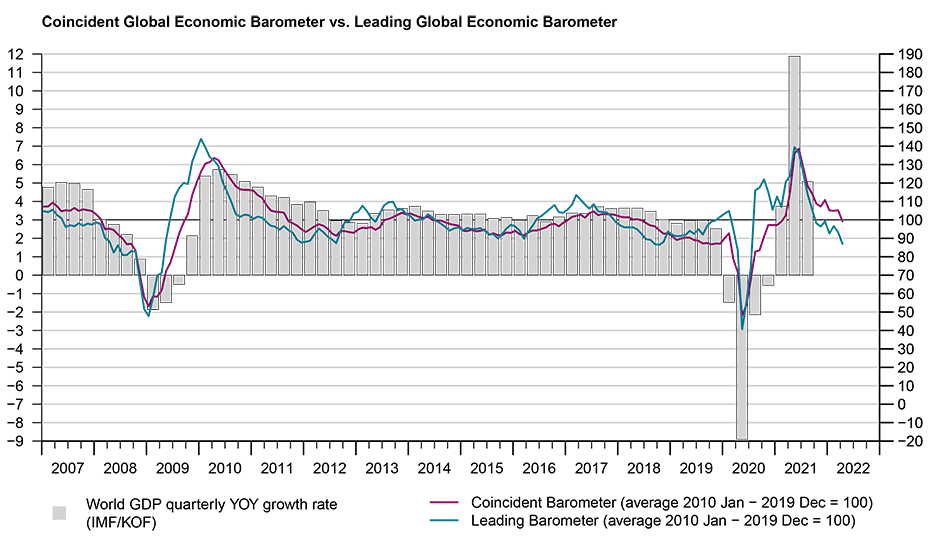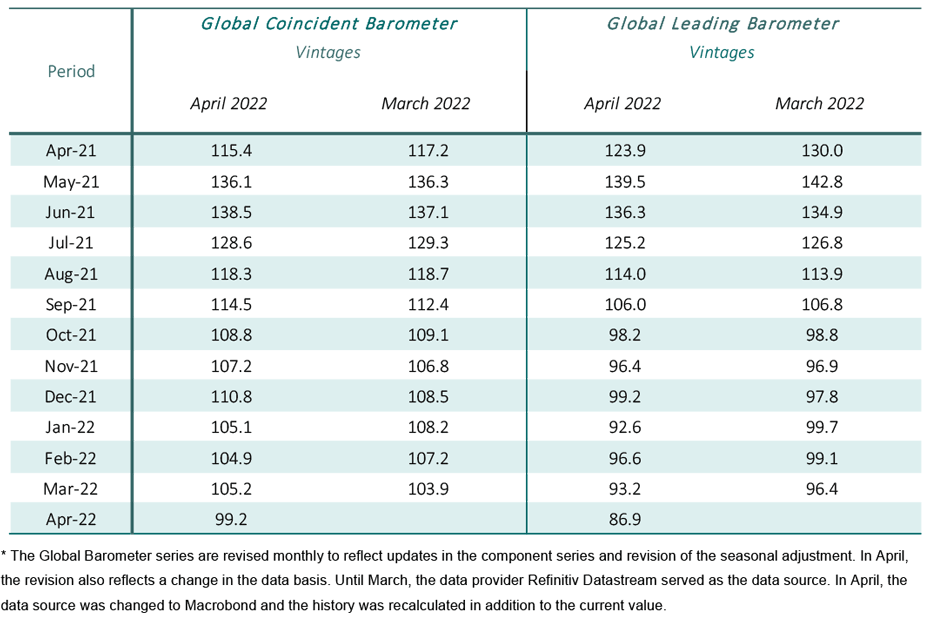Global Barometers fall due to the war in Europe and the increases in COVID-19 cases in China
The Global Barometers decrease in April, likely reflecting shocks such as the war in Ukraine and the increase in the number of COVID-19 cases in China. The Coincident Barometer is now below the historical mean of 100 points for the first time since February 2021. In addition, the more noticeably drop in the Leading Barometer signals the perspective of a stronger deceleration in world growth for the coming months.
The Coincident Global Economic Barometer falls 6.1 points in April to 99.2 points, the lowest level since January of last year (97.2 pts), while the Leading Global Economic Barometer decreases 6.3 points, to 86.9 points, the lowest level since July 2020 (74.2 pts). The decline of the Coincident indicator is influenced mainly by the Asia, Pacific, and Africa region. The drop in the Leading indicator is motivated almost exclusively by the worsening of perspectives in European countries.
“Russia's invasion of Ukraine is sending shock waves not only politically but also economically. For Europe in particular, the economic outlook has deteriorated sharply. Higher energy prices, associated to a shift in demand away from Russian primary commodities, but also a further layer on top of the supply chain problems already in place, cause companies to judge the coming months to become challenging. The upswing triggered by the lifting of pandemic-related restrictions seems to be overshadowed also economically by this war in Europe.”, evaluates Prof Jan-Egbert Sturm, Director of KOF Swiss Economic Institute.

Coincident Barometer – regions and sectors
In April, all three regional indicator bundles decrease. The Asia, Pacific, and Africa region contributes negatively 3.7 points (61%) to the fall in the Coincident Global Barometer. The indicator for Europe contributes -1.9 pts. and the Western Hemisphere contributes only -0.5 points. The drop in the regional indicators reflects a change in the assessment of the current economic growth in the face of the worsening pandemic development in China and the idea of continued COVID-19 risk, in addition to the outbreak of the Russia-Ukraine war and its first impacts on the economy. The graph below illustrates the contribution of each region to the deviation of the Coincident Barometer from the historical mean of 100 points.
All the coincident sector indicator bundles decrease this month. The largest fall stems from the Industry and Construction sectors, with marginal losses of over 8.0 points, followed by Trade which declined 6.2 points. With these results, three of the five sector indicators are now below their respective historical mean of 100 points.
Leading Barometer – regions and sectors
The Leading Global Barometer leads the world economic growth rate cycle by three to six months on average. Europe contributes 6.0 points (95%) to the 6.3-point decrease in the global indicator. The Western Hemisphere contributes -0.6 points, while the indicator for the Asia, Pacific, and Africa region increases and contributes 0.3 points in the opposite direction. Europe records its lowest level since July 2020 (68.3 pts.). This result suggests that growth expectations for the coming months have been strongly revised, with increased pessimism after the outbreak of the war between Russia and Ukraine.
In April 2022, there is a fall in all Leading indicator sectors, except Construction. Industry declines more than 12 points to 87.3 points, its lowest level since July 2020 (82.7 pts). In addition to the existing problems in industrial supply chains in various countries, extension of the conflict in Europe adds further uncertainties regarding performance of the sector. In the other sectors, the impact until now is smaller.

The full press release with tables and graphs can be found Download here (PDF, 676 KB).
More information on the Global Economic Barometers can be found here.
The Global Economic Barometers
The Global Economic Barometers are a system of indicators enabling timely analysis of global economic development. They represent a collaboration between the KOF Swiss Economic Institute of the ETH Zurich in Switzerland and Fundação Getulio Vargas (FGV), based in Rio de Janeiro, Brazil. The system consists of two composite indicators, the Coincident Barometer and the Leading Barometer. The Coincident Barometer reflects the current state of economic activity, while the Leading Barometer provides a cyclical signal roughly six months ahead of current economic developments.
The two Barometers comprise the results of economic tendency surveys conducted in more than 50 countries with the aim of achieving the broadest possible global coverage. The advantages of economic tendency surveys are that their results are usually readily available and are not substantially revised after first publication.
The Coincident Barometer includes more than 1,000 different time series, while the Leading Barometer consists of over 600 time series. Cross-correlation analysis is used to decide which individual time series are included in the barometers. This involves correlating the individual time series with a reference series. The reference series used is the year-on-year growth rate of global gross domestic product (GDP), where the individual national GDPs are aggregated at purchasing power parity to form global GDP. A time series is only included in a Barometer if it shows a sufficiently high correlation and a suitable synchronization or lead with the reference series. The time period used for this correlation analysis currently runs from January 2010 to December 2019.
The series of the two Barometers are revised each month at publication and are standardized to have a mean of 100 and a standard deviation of 10 for the 10-year period previous to the most recent observations.
The methodology is described in:
Klaus Abberger, Michael Graff, Aloisio Jr. Campelo, Anna Carolina Lemos Gouveia, Oliver Müller and Jan-Egbert Sturm (2020), The Global Economic Barometers: Composite indicators for the world economy. KOF Working Papers, vol. 471, Zurich: KOF Swiss Economic Institute, ETH Zurich, 2020.
Contact
KOF Konjunkturforschungsstelle
Leonhardstrasse 21
8092
Zürich
Switzerland